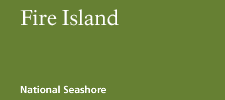 |
 | |
  | |
|
|
|
|
Fire Island National Seashore
Science Synthesis Papers & Other Recent Scientific Reports
|
|
|
|
|
| |
 |
|
Operating under a formal agreement with the National Park Service, a network of Cooperative Ecosystem Studies Units (CESUs) provides research, technical assistance, and education to resource and environmental managers. The published in 2005 a series of to support the preparation of a new for Fire Island National Seashore.
-
-
Bay Shoreline Physical Processes, Fire Island
(Fire Island National Seashore Science Synthesis Paper)
Technical Report NPS/NER/NRTR—2005/020
by Karl F. Nordstrom, Rutgers University
Nancy L. Jackson, New Jersey Institute of Technology
September 2005
-
-
(Fire Island National Seashore Science Synthesis Paper)
Technical Report NPS/NER/NRTR—2005/023
by David O. Conover, Robert Cerrato, and William Wise, Stony Brook University
December 2005
-
-
|
|
Additional Natural Resources Reports and Technical Reports are also produced by or for the National Park Service.
-
Technical Report NPS/NER/NRTR—2008/132
by Norbert P. Psuty and Tanya M. Silveira
September 2008
-
Technical Report NPS/NER/NRTR—2008/131
Executive Summary
by Meredith G. Kratzmann and Cheryl J. Hapke
October 2008
Technical Report NPS/NER/NRTR—2008/114
Executive Summary
by Erika E. Lentz, Cheryl J. Hapke, and William C. Schwab
March 2008
-
HDRU Series Publication 07-8
Study Background and Purpose
by William F. Siemer, Kirsten M. Leong, Daniel J. Decker, and Karlene K. Smith
December 2007
-
Technical Report NPS/NER/NRTR—2007/089
Abstract
by C. T. Roman, J.W. King, D. R. Cahoon, J.C. Lynch, and P.G. Appleby
July 2007
-
Technical Report NPS/NER/NRTR—2007/075
Abstract
by S. J. Williams and M. K. Foley
National Park Service
February 2007
-
Introduction
by James R. Allen, Charles L. LaBash and Peter V. August, and Norbert P. Psuty
April 2002
-
|
|
Other recent publications provide valuable background information to help you better understand the resources and natural processes of Fire Island National Seashore.
Additional comprehensive research and studies have been conducted by the U. S. Army Corps of Engineers to identify, evaluate and recommend long-term solutions for hurricane and storm damage reduction for homes and businesses within the floodplain extending along 83-miles of ocean and bay shorelines from Fire Island Inlet to Montauk Point. This study area includes the shoreline of Fire Island National Seashore.
|
|
|
|

Biennial Science & Resource Management Conference
Sponsored by the park, this program provides a public glimpse into current research and planning.
more... | | 
General Management Plan
Fire Island National Seashore has begun the process of preparing a new GMP. Learn how you can help.
more... | |
|
|
|
|
|
|
|
 |
|
Did You Know?
Tiny insectivorous plants called sundews (Drosera rotundifolia and D. intermedia) may be found in the low moist swales between dunes in the Fire Island wilderness area. Sundew gets its name from the glistening sticky substance on its leaves that traps ants and other small insects.
more...
|
|
|
|
Last Updated: April 23, 2009 at 18:17 EST |








